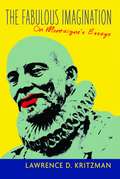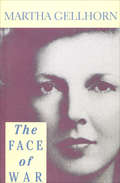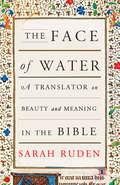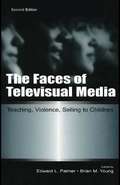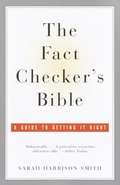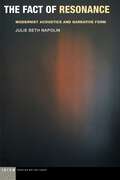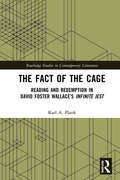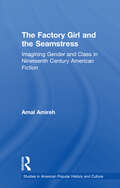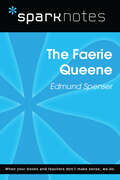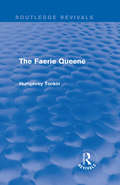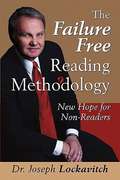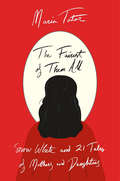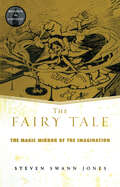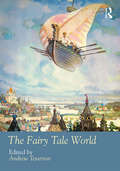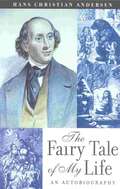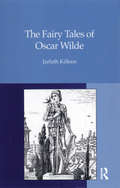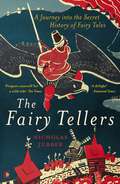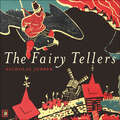- Table View
- List View
The Fabulous Imagination: On Montaigne's Essays
by Lawrence D. Kritzman"This is one of the few books on Montaigne that fuses analytical skill with humane awareness of why Montaigne matters."-Harold Bloom, Sterling Professor of Humanities, Yale University"In this exhilarating and learned book on Montaigne's essays, Lawrence D. Kritzman contemporizes the great writer. Reading him from today's deconstructive America, Kritzman discovers Montaigne always already deep into a dialogue with Jacques Derrida and psychoanalysis. One cannot but admire this fabulous act of translation."-Hélène Cixous"Throughout his career, Lawrence D. Kritzman has demonstrated an intimate knowledge of Montaigne's essays and an engagement with French philosophy and critical theory. The Fabulous Imagination sheds precious new light on one of the founders of modern individualism and on his crucial quest for self-knowledge."-Jean Starobinski, professor emeritus of French literature, University of GenevaMichel de Montaigne's (1533-1592) Essais was a profound study of human subjectivity. More than three hundred years before the advent of psychoanalysis, Montaigne embarked on a remarkable quest to see and imagine the self from a variety of vantages. Through the questions How shall I live? How can I know myself? he explored the significance of monsters, nightmares, and traumatic memories; the fear of impotence; the fragility of gender; and the act of anticipating and coping with death. In this book, Lawrence D. Kritzman traces Montaigne's development of the Western concept of the self. For Montaigne, imagination lies at the core of an internal universe that influences both the body and the mind. Imagination is essential to human experience. Although Montaigne recognized that the imagination can confuse the individual, "the fabulous imagination" can be curative, enabling the mind's "I" to sustain itself in the face of hardship. Kritzman begins with Montaigne's study of the fragility of gender and its relationship to the peripatetic movement of a fabulous imagination. He then follows with the essayist's examination of the act of mourning and the power of the imagination to overcome the fear of death. Kritzman concludes with Montaigne's views on philosophy, experience, and the connection between self-portraiture, ethics, and oblivion. His reading demonstrates that the mind's I, as Montaigne envisioned it, sees by imagining that which is not visible, thus offering an alternative to the logical positivism of our age.
The Face of War: Writings From The Frontline, 1937-1985
by Martha GellhornMartha Gellhorn (1908–1998) was a war correspondent for nearly fifty years. From the Spanish Civil War in 1937 through the wars in Central America in the mid-eighties, her candid reports reflected her feelings for people no matter what their political ideologies, and the openness and vulnerability of her conscience. I wrote very fast, as I had to,” she says, afraid that I would forget the exact sound, smell, words, gestures, which were special to this moment and this place.” Whether in Java, Finland, the Middle East, or Vietnam, she used the same vigorous approach. Collected here together for the first time, The Face of War is what The New York Times called a brilliant anti-war book.”
The Face of Water: A Translator on Beauty and Meaning in the Bible
by Sarah RudenA dazzling reconsideration of the original languages and texts of the Bible, in both the Old and the New Testaments, from the acclaimed scholar and translator of Classical literature (“The best translation of the Aeneid, certainly the best of our time” —Ursula Le Guin; “The first translation since Dryden that can be read as a great English poem in itself” —Garry Wills, The New York Review of Books) and author of Paul Among the People (“Astonishing . . . Superb” —Booklist, starred review). In The Face of Water, Sarah Ruden brilliantly and elegantly explains and celebrates the Bible’s writings. Singling out the most famous passages, such as the Genesis creation story, the Ten Commandments, the Lord’s Prayer, and the Beatitudes, Ruden reexamines and retranslates from the Hebrew and Greek what has been obscured and misunderstood over time. Making clear that she is not a Biblical scholar, cleric, theologian, or philosopher, Ruden—a Quaker—speaks plainly in this illuminating and inspiring book. She writes that while the Bible has always mattered profoundly, it is a book that in modern translations often lacks vitality, and she sets out here to make it less a thing of paper and glue and ink and more a live and loving text. Ruden writes of the early evolution, literary beauty, and transcendent ideals of the Hebrew Bible and the Greek New Testament, exploring how the Jews came to establish the greatest, most enduring book on earth as their regional strategic weakness found a paradoxical moral and spiritual strength through their writings, and how the Christians inherited and adapted this remarkable literary tradition. She writes as well about the crucial purposes of translation, not only for availability of texts but also for accountability in public life and as a reflection of society’s current concerns. She shows that it is the original texts that most clearly reveal our cherished values (both religious and secular), unlike the standard English translations of the Bible that mask even the yearning for freedom from slavery. The word “redemption” translated from Hebrew and Greek, meaning mercy for the exploited and oppressed, is more abstract than its original meaning—to buy a person back from captivity or slavery or some other distress. The Face of Water is as much a book about poetry, music, drama, raw humor, and passion as it is about the idealism of the Bible. Ruden’s book gives us an unprecedented, nuanced understanding of what this extraordinary document was for its earliest readers and what it can still be for us today
The Faces of Televisual Media: Teaching, Violence, Selling To Children (Routledge Communication Series)
by EDWARD L.PALMER and BRIAN M.YOUNGThis collection offers original, state-of-the-art contributions from leading authorities in children's televisual media. International researchers from communication and psychology provide readers with ready access to current televisual research, trends, and policymaking/political climate issues pertaining to children. This second edition provides a current summary of studies on content, viewing patterns, comprehension, effects, and individual differences in instructional and educational programming, televisual entertainment and violence programming, and televisual advertising to children. Editors Edward L. Palmer and Brian M. Young have structured the volume into three sections examining the "faces" of television: the Teaching (instructional/educational) Face, the Violent Face, and the Selling (advertising) Face. Chapters within each section identify and focus recurrent themes while integrating them topically into a coherent whole. Each area incorporates new technologies and considers their potentials, effects, and future. Subjects featured in the various chapters include: *cross-cultural and historical comparisons with an in-depth perspective on the BBC and other European/Asian televisual media roots, as well as America's formative televisual media roots; *an examination of key differences between developed and developing countries; *implications of emerging instructional/educational media for children's education--addressing both cognitive and multi-ethnic aspects; and * prominent, informed challenge to the prevailing popular view that children are unaffected and unharmed by exposure to media violence. This volume informs ongoing debates across a broad spectrum of current, critical issues, and suggests avenues for future research. It is pertinent and provocative for the most sophisticated scholar in the field, as well as for students in areas of developmental or social psychology, communication, education, sociology, marketing, broadcasting and film, public policy, advertising, and medicine/pediatrics. It is also appropriate for courses in children, media, and society.
The Fact Checker's Bible: A Guide to Getting It Right
by Sarah Harrison SmithThe first book of its kind,The Fact Checker’s Bibleis the essential guide to the important but often neglected task of checking facts, whatever their source. Today, everyone is overwhelmed with information that claims to be factual. But even the most punctilious researcher, writer, student or journalist--not to mention the lazy or deliberately mendacious ones--can sometimes get it wrong. So checking facts has become a more pressing task. But how to go about it? The Fact Checker’s Biblecovers: *Reading for accuracy *Determining what to check *Researching the facts *Assessing sources: people, newspapers and magazines, books, the Internet, etc. *Checking quotations *Understanding the legal liabilities of getting it wrong *Looking out for and avoiding the dangers of plagiarism For everyone from students to editors to journalists, the methods and practices outlined inThe Fact Checker’s Bibleprovides both a standard and a working manual for how to get the facts right. From the Trade Paperback edition.
The Fact of Resonance: Modernist Acoustics and Narrative Form (Idiom: Inventing Writing Theory)
by Julie Beth NapolinShortlisted, 2021 Memory Studies Association First Book AwardThe Fact of Resonance returns to the colonial and technological contexts in which theories of the novel developed, seeking in sound an alternative premise for theorizing modernist narrative form. Arguing that narrative theory has been founded on an exclusion of sound, the book poses a missing counterpart to modernism’s question “who speaks?” in the hidden acoustical questions “who hears?” and “who listens?”For Napolin, the experience of reading is undergirded by the sonic. The book captures and enhances literature’s ambient sounds, sounds that are clues to heterogeneous experiences secreted within the acoustical unconscious of texts. The book invents an oblique ear, a subtle and lyrical prose style attuned to picking up sounds no longer hearable. “Resonance” opens upon a new genealogy of modernism, tracking from Joseph Conrad to his interlocutors—Sigmund Freud, Frantz Fanon, W. E. B. Du Bois, William Faulkner, and Chantal Akerman—the racialized, gendered, and colonial implications of acoustical figures that “drift” through and are transformed by narrative worlds in writing, film, and music.A major synthesis of resources gleaned from across the theoretical humanities, the book argues for “resonance” as the traversal of acoustical figures across the spaces of colonial and technological modernity, figures registering and transmitting transformations of “voice” and “sound” across languages, culture, and modalities of hearing. We have not yet sufficiently attended to relays between sound, narrative, and the unconscious that are crucial to the ideological entailments and figural strategies of transnational, transatlantic, and transpacific modernism. The breadth of the book’s engagements will make it of interest not only to students and scholars of modernist fiction and sound studies, but to anyone interested in contemporary critical theory.
The Fact of the Cage: Reading and Redemption In David Foster Wallace’s "Infinite Jest" (Routledge Studies in Contemporary Literature)
by Karl A. PlankDavid Foster Wallace’s Infinite Jest raised expectations of what a novel might do. As he understood fiction to aim at what it means to be human, so he hoped his work might relieve the loneliness of human suffering. In that light, The Fact of the Cage shows how Wallace’s masterpiece dramatizes the condition of encagement and how it comes to be met by "Abiding" and through inter-relational acts of speaking and hearing, touching, and facing. Revealing Wallace’s theology of a "boneless Christ," The Fact of the Cage wagers that reading such a novel as Infinite Jest makes available to readers the redemption glimpsed in its pages, that reading fiction has ethical and religious significance—in short, that reading Infinite Jest makes one better. As such, Plank’s work takes steps to defend the ethics of fiction, the vital relation between religion and literature, and why one just might read at all.
The Factory Girl and the Seamstress: Imagining Gender and Class in Nineteenth Century American Fiction (Studies in American Popular History and Culture)
by Amal AmirehThis book studies the representations of working-class women in canonical and popular American fiction between 1820 and 1870. These representations have been invisible in nineteenth century American literary and cultural studies due to the general view that antebellum writers did not engage with their society's economic and social relaities. Against this view and to highlight the cultural importance of working-class women, this study argues that, in responding to industrialization, middle class writers such as Melville, Hawthorne, Fern, Davies, and Phelps used the figures of the factory worker and the seamstress to express their anxieties about unstable gender and class identitites. These fictional representations were influenced by, and contributed to, an important but understudied cultural debate about wage labor, working women, and class.
The Faerie Queen (SparkNotes Literature Guide Series)
by SparkNotesThe Faerie Queen (SparkNotes Literature Guide) by Edmund Spenser Making the reading experience fun! Created by Harvard students for students everywhere, SparkNotes is a new breed of study guide: smarter, better, faster.Geared to what today's students need to know, SparkNotes provides:chapter-by-chapter analysis explanations of key themes, motifs, and symbols a review quiz and essay topics Lively and accessible, these guides are perfect for late-night studying and writing papers.
The Faerie Queene (Routledge Revivals)
by Humphrey TonkinEdmund Spenser’s The Faerie Queene is among the most important literary products of the Elizabethan age, and the vast sweep of its moral, political and social concerns tells us more about the age than any other work. This volume, first published in 1989, offers detailed readings of each of the poem’s seven books, along with introductory chapters on Spenser’s career, and the roots of the poem in the English and continental traditions. Humphrey Tonkin pays particular attention to the work’s political and cultural role and its contribution to the development of Elizabethan ideology. A comprehensive analysis, this reissue will be of particular value to literature students and academics alike.
The Failure Free Reading Methodology: New Hope for Non-readers
by Joseph LockavitchThis book provides the insight into a new corrective reading action. The time has come to stop giving up on failing students and this book shows how.
The Fairest of Them All: Snow White and 21 Tales of Mothers and Daughters
by Maria TatarWe think we know the story of Snow White from Disney and the Brothers Grimm. But acclaimed folklorist Maria Tatar reveals dazzling variations from across the globe. The story of the rivalry between a beautiful, innocent girl and her equally beautiful and cruel mother has been endlessly repeated and refashioned all over the world. In Switzerland you might hear about seven dwarfs who shelter a girl, only to be murdered by robbers. In Armenia a mother orders her husband to kill his daughter because the moon has declared her “the most beautiful of all.” The Brothers Grimm gave this story the name by which we know it best, and in 1937 Walt Disney sweetened their somber version to make the first feature-length, animated fairy tale, Snow White and the Seven Dwarfs. Since then the Disney film has become our cultural touchstone—the innocent heroine, her evil stepmother, the envy that divides them, and a romantic rescue from domestic drudgery and maternal persecution. But, as every fan of the story knows, there is more to Snow White than that. The magic mirror, the poisoned apple, the catatonic sleep, and the strange scene of revivification are important elements in the phantasmagoria of the Snow White universe. Maria Tatar, an acclaimed folklorist and translator, brings to life a global melodrama of mother-daughter rivalries that play out across countries and cultures.
The Fairy Tale (Genres in Context)
by Steven Swann JonesOne of the best known and enduring genres, the fairy fales origins extend back to the preliterate oral societies of the ancient world. This books surveys its history and traces its evolution into the form we recognized today. Jones Builds on the work of folklorist and critics to provide the student with a stunning, lucid overview of the genre and a solid understanding of its structure.
The Fairy Tale World (Routledge Worlds)
by Andrew TeversonThe Fairy Tale World is a definitive volume on this ever-evolving field. The book draws on recent critical attention, contesting romantic ideas about timeless tales of good and evil, and arguing that fairy tales are culturally astute narratives that reflect the historical and material circumstances of the societies in which they are produced. The Fairy Tale World takes a uniquely global perspective and broadens the international, cultural, and critical scope of fairy-tale studies. Throughout the five parts, the volume challenges the previously Eurocentric focus of fairy-tale studies, with contributors looking at: • the contrast between traditional, canonical fairy tales and more modern reinterpretations; • responses to the fairy tale around the world, including works from every continent; • applications of the fairy tale in diverse media, from oral tradition to the commercialized films of Hollywood and Bollywood; • debates concerning the global and local ownership of fairy tales, and the impact the digital age and an exponentially globalized world have on traditional narratives; • the fairy tale as told through art, dance, theatre, fan fiction, and film. This volume brings together a selection of the most respected voices in the field, offering ground-breaking analysis of the fairy tale in relation to ethnicity, colonialism, feminism, disability, sexuality, the environment, and class. An indispensable resource for students and scholars alike, The Fairy Tale World seeks to discover how such a traditional area of literature has remained so enduringly relevant in the modern world.
The Fairy Tale of My Life: An Autobiography
by Hans Christain AndersonDanish poet and novelist Hans Christian Andersen (1805-1875) is best known for the dozens of fairy tales he wrote, including "The Little Mermaid," "The Ugly Duckling," and "The Snow Queen." Andersen's sense of fantasy, power of description, and acute sensitivity are strikingly evident in his autobiography. Andersen masterfully depicts the extreme poverty of his provincial childhood and the international celebrity of his later years, and also provides insights into the sources of many of his most famous tales.
The Fairy Tales of Oscar Wilde
by Jarlath KilleenOscar Wilde's two collections of children's literature, The Happy Prince and Other Stories (1888) and A House of Pomegranates (1891), have often been marginalised in critical accounts as their apparently conservative didacticism appears at odds with the characterisation of Wilde as an amoral aesthete. In this, the first full-length study of Wilde's fairy tales for children, Jarlath Killeen argues that Wilde's stories are neither uniformly conservative nor subversive, but a blend of both. Killeen contends that while they should be read in relation to a literary tradition of fairy tales that emerged in nineteenth century Europe; Irish issues heavily influenced the work. These issues were powerfully shaped by the 'folk Catholicism' Wilde encountered in the west of Ireland. By resituating the fairy tales in a complex nexus of theological, political, social, and national concerns, Killeen restores the tales to their proper place in the Wilde canon.
The Fairy Tellers: A Journey into the Secret History of Fairy Tales
by Nicholas Jubber'Like a child after the Pied Piper I pursued Jubber into a world both human and full of magic. A carnival of a book, rigorously researched and jostling with life' Amy Jeffs, author of Storyland: A New Mythology of Britain'Magical tales about magical tales and tellers. Jubber, congenially and fascinatingly, explores the land from which the great fairy stories seeped, making the stories more resonant, powerful and important than ever' Charles Foster, author of Being a Human and Being a BeastWho were the Fairy Tellers?In this far-ranging quest, award-winning author Nicholas Jubber unearths the lives of the dreamers who made our most beloved fairy tales: inventors, thieves, rebels and forgotten geniuses who gave us classic tales such as 'Cinderella', 'Hansel and Gretel', 'Beauty and the Beast' and 'Baba Yaga'.From the Middle Ages to the birth of modern children's literature, they include a German apothecary's daughter, a Syrian youth running away from a career in the souk and a Russian dissident embroiled in a plot to kill the tsar.Following these and other unlikely protagonists, we travel from the steaming cities of Italy and the Levant, under the dark branches of the Black Forest, deep into the tundra of Siberia and across the snowy fells of Lapland. In the process, we discover a fresh perspective on some of our most frequently told stories. Filled with adventure, tragedy and real-world magic, this bewitching book uncovers the stranger lives behind the strangest of tales.
The Fairy Tellers: A Journey into the Secret History of Fairy Tales
by Nicholas JubberThe surprising origins and people behind the world's most influential magical tales: the people who told and re-shaped them, the landscapes that forged them, and the cultures that formed them and were in turn formed by them.Fairy-Tales are not just fairy-tales: they are records of historical phenomena, telling us something about how Western civilisation was formed. In The Fairy-Tellers' Trail, award-winning travel-writer Nick Jubber explores their secret history of fairy-tales: the people who told them, the landscapes that forged them, and the cultures that formed them. While there are certain names inextricably entwined with the concept of a fairy-tale, such as the Brothers Grimm and Hans Christian Andersen, the most significant tellers are long buried under the more celebrated figures who have taken the credit for their stories - people like the Syrian storyteller Youhenna Diab and the Wild Sisters of Cassel. Without them we would never have heard of Aladdin, his Magic Lamp or the adventures of Hansel and Gretel. Tracking these stories to their sources carries us through the steaming cities of Southern Italy and across the Mediterranean to the dust-clogged alleys of the Maghreb, under the fretting leaves of the Black Forest, deep into the tundra of Siberia and across the snowy hills of Lapland.From North Africa and Siberia, this audiobook illuminates the complicated relationship between Western civilisation and the 'Eastern' cultures it borrowed from, and the strange lives of our long lost fairy-tellers.(P) 2022 Hodder & Stoughton Limited
The Fairy Way of Writing: Shakespeare to Tolkien
by Kevin PaskA history of popular superstitions, tales, and magic in British literature. In The Fairy Way of Writing, Kevin Pask seeks to explain the origins and popularity of enchantment in Shakespeare’s plays. Writers John Dryden and Joseph Addison originated the phrase "fairy way of writing" to define the concept of an English creative imagination founded on a synthesis of high literary culture and the popular culture of tales and superstitions. Beginning with Chaucer, Johnson, Dryden, and Milton, Pask argues that the fairy way of writing not only sets the stage for the fairy tale, the Gothic novel, and children’s literature but also informs genres beyond the English canon, including painting, twentieth-century fantasy fiction, and French fairy tales. In addition to English writers and visual artists such as Pope, Blake, and Keats, who were directly engaged with Shakespearean fantasy, Pask also examines fairy tales, letters, and paintings by the French writers Madame d'Aulnoy, Charles Perrault, Madame de Sévigné, and the Swiss-born artist Johann Heinrich Füssli (Fuseli).The Fairy Way of Writing alters the traditional sense of English literary history and of Shakespeare’s singular place in it, insisting on the importance of often-overlooked literary and visual works. It recovers a distinctive aspect of English literary culture from across the entire early modern era and beyond, one that has been studied in the context of individual periods and writers but is only now explored in relation to the history of European nationalism and the creation of the modern literary system.
The Faith of a Writer: Life, Craft, Art
by Joyce Carol OatesA tribute to the brilliant craftsmanship of one of our most distinguished writers, providing valuable insight into her inspiration and her method Joyce Carol Oates is widely regarded as one of America's greatest contemporary literary figures. Having written in a number of genres -- prose, poetry, personal and critical essays, as well as plays -- she is an artist ideally suited to answer essential questions about what makes a story striking, a novel come alive, a writer an artist as well as a craftsman. In The Faith of a Writer, Oates discusses the subjects most important to the narrative craft, touching on topics such as inspiration, memory, self-criticism, and "the unique power of the unconscious." On a more personal note, she speaks of childhood inspirations, offers advice to young writers, and discusses the wildly varying states of mind of a writer at work. Oates also pays homage to those she calls her "significant predecessors" and discusses the importance of reading in the life of a writer. Oates claims, "Inspiration and energy and even genius are rarely enough to make 'art': for prose fiction is also a craft, and craft must be learned, whether by accident or design." In fourteen succinct chapters, The Faith of a Writer provides valuable lessons on how language, ideas, and experience are assembled to create art.
The Faithful Artist: A Vision for Evangelicalism and the Arts (Studies in Theology and the Arts #Coming In August)
by Cameron J. AndersonThe tension between Christianity and the arts is often real. But it also offers a false dichotomy. Many Christian artists think that they must choose between their faith and their artistic calling. Drawing upon his experiences as both a Christian and a practicing artist, Cameron J. Anderson explores the dynamics of faith and art in this latest volume in IVP Academic?s Studies in Theology and the Arts series. Tracing the relationship between evangelicalism and modern art in postwar America—two entities that often found themselves at odds with each other—Anderson raises several issues that confront artists. With skill, sensitivity and insight, he considers questions such as the role of our bodies and our senses in our experience of the arts, the relationship between text and image, the persistent dangers of idolatry, the possibility of pursuing God through an encounter with beauty and more. Throughout this study, Anderson's principal concern is how Christian artists can faithfully pursue their vocational calling in contemporary culture. Readers will find here not only an informed and thoughtful response, but also a vision that offers guidance and hope.
The Fall of Cities in the Mediterranean
by Dorota Dutsch Bachvarova, Mary R. and Dutsch, Dorota and Suter, Ann Mary R. Bachvarova Ann SuterA body of theory has developed about the role and function of memory in creating and maintaining cultural identity. Yet there has been no consideration of the rich Mediterranean and Near Eastern traditions of laments for fallen cities in commemorating or resolving communal trauma. This volume offers new insights into the trope of the fallen city in folk-song and a variety of literary genres. These commemorations reveal memories modified by diverse agendas, and contains narrative structures and motifs that show the meaning of memory-making about fallen cities. Opening a new avenue of research into the Mediterranean genre of city lament, this book examines references to, or re-workings of, otherwise lost texts or ways of commemorating fallen cities in the extant texts, and with greater emphasis than usual on the point of view of the victors.
The Fall of Language in the Age of English
by Juliet Winters Carpenter Minae Mizumura translated by Mari YoshiharaMinae Mizumura was born in Tokyo, moved to New York at the age of twelve, and studied French literature at Yale University. Acclaimed for her audacious experimentation and skillful storytelling, Mizumura has won major literary awards for all four of her novels--one of which, A True Novel, recently was published in English. She lives in Tokyo.
The Fall of Language in the Age of English
by Juliet Winters Carpenter Mari Yoshihara Minae MizumuraMinae Mizumura was born in Tokyo, moved to New York at the age of twelve, and studied French literature at Yale University. Acclaimed for her audacious experimentation and skillful storytelling, Mizumura has won major literary awards for all four of her novels--one of which, A True Novel, recently was published in English. She lives in Tokyo.
